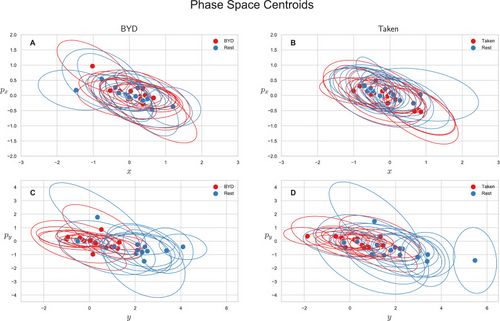Store:Exel07
Phase space
We also explored the average-valued phase space of this system. The phase space for each subject was plotted as the average position and momentum along the direction or as the average position and momentum along the direction . Figure 2 shows the centroids of the phase space scatter plots for each subject with an ellipse representing the one standard deviation confidence interval. Note that values are only reported for the intact stimuli as an analysis of variance shows the scrambled and intact movies are indistinguishable in phase space (P, Tukey adjusted). Figure 2A and B show the projection of the phase space centroid onto the plane spanned by and for “Bang! You’re Dead” and “Taken” respectively, and Fig. 2C and D () plane. The average position along the axis for the intact stimulus (“BYD” and “Taken”) and their scrambled forms are significantly different from the pre-stimulus rest counterparts with (Tukey adjusted) whereas the task-positive and resting centroids are indistinguishable in the plane (, Tukey adjusted). The averages of the group are reported in Table Table11 along with their standard deviations. These values are the averaged value of the centroids (average of the within stimuli centre points in Fig. 2) for the respective position/momenta within each stimulus level. As also seen in Fig. 2C and D, there is a striking difference of one order of magnitude for between the resting and task conditions, yet no marked differences in , , or .













